Alfred Hitchcock’s ‘The Birds’ Explained: Nature’s Revenge
This article takes you through everything you need to understand Alfred Hitchcock’s film “The Birds”— origin story, characters, overall themes, and more.
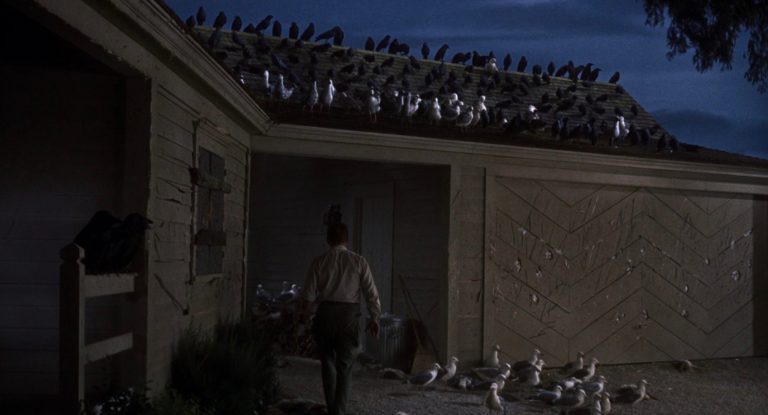
Whereas Alfred Hitchcock’s Psycho (1960) can rightly be called the first modern horror film, The Birds (1963) is probably the first modern end-of-the-world film. Federico Fellini called it an “apocalyptic poem.” The Birds is also more disturbing than Psycho because there’s no resolution at the end—in fact, the film doesn’t end at all. It builds up the tension more slowly than Psycho did, but once the bird attacks start, they keep happening and get worse each time. At the end, you’re left hanging, which was precisely Hitchcock’s intent.

Although the film seems to leave a lasting impression on everyone who’s ever seen it, many people express frustration that there is no happy ending and that the film doesn’t beat you over the head with a message. In this essay we’ll explain the meaning and symbolism behind those mysteriously angry birds. I’ll also present analysis and theories not only from film critics and academics, but from Hitchcock himself, and the origins of the movie.
Origin Story
In some ways, the movie is based on a book. “The Birds” was the name of a 1952 novella by author Daphne Du Maurier that centered on the Hockens, a farming family who lived in rural England where the community is suddenly beset with waves of violent attacks who are so set on destruction that they often kill themselves in the process. And whereas the ending of the film is unclear, in the novella one is made certain that the world is ending.

However, the screenplay is almost entirely different from the novella. The only thing that Hitchcock’s film shares in common with Daphne Du Maurier’s is the theme of birds attacking without explanation. Otherwise, Hitchcock hired Evan Hunter to write a screenplay based in America rather than England, and with a screwball-comedy subplot that consumes the film’s first hour—an element that is entirely missing in the story. None of the characters share the same names as those in the novella, either. Daphne Du Maurier was reportedly displeased with the film version of The Birds.
The birds was also inspired by a real-life bird attack. On August 18, 1961 the Santa Cruz Sentinel newspaper blared with the headline “Seabird Invasion Hits Coastal Homes.” It claimed that “millions” of birds smashed into cars and buildings in the tiny town of Capitola and even attempted to enter houses. It says that when flashlight-wielding citizens went outside in the middle of the night to see what was going on, hostile birds drove them right back into their houses. After some research, it was revealed that the attacking birds were sooty shearwaters who had feasted on nearby anchovies and were likely driven insane by nerve-damaging toxins in the contaminated food.
The scene where the birds invade the house through the Brenners’ chimney may have been inspired by an April 1960 incident in La Jolla, CA, in which hundreds of Vaux Swifts invaded a married couple’s house through the chimney and wreaked havoc.
In the town of Bodega—which is near Bodega Bay—farmers reportedly told Hitchcock about how crows had plucked out the eyes of newborn lambs, possibly inspiring the scene in The Birds where a farmer has his eyes pecked out. In a supreme irony, Daphne Du Maurier’s son claims to have been attacked by hostile seagulls at an English coastal resort in the early 2000s.
Movie Poster

The centerpiece of this poster is a drawing that depicts the climactic scene where Tippi Hedren is mercilessly attacked by a swarm of gulls after she innocently wandered into the attic seeking the source of some rustling noises she’d heard. Hitchcock is shown in his typically droll Master of Ceremonies pose as he proclaims it’s possibly the scariest film he’s ever made—and remember, this is his first film after the legendarily terrifying Psycho.
Cast
Tippi Hedren, in her acting debut, stars as spoiled socialite Melanie Daniels. From the moment in 1961 when he spotted the beautiful blonde model in a diet drink commercial, Hitchcock had his heart set on Hedren, and only Hedren, to play the female lead.
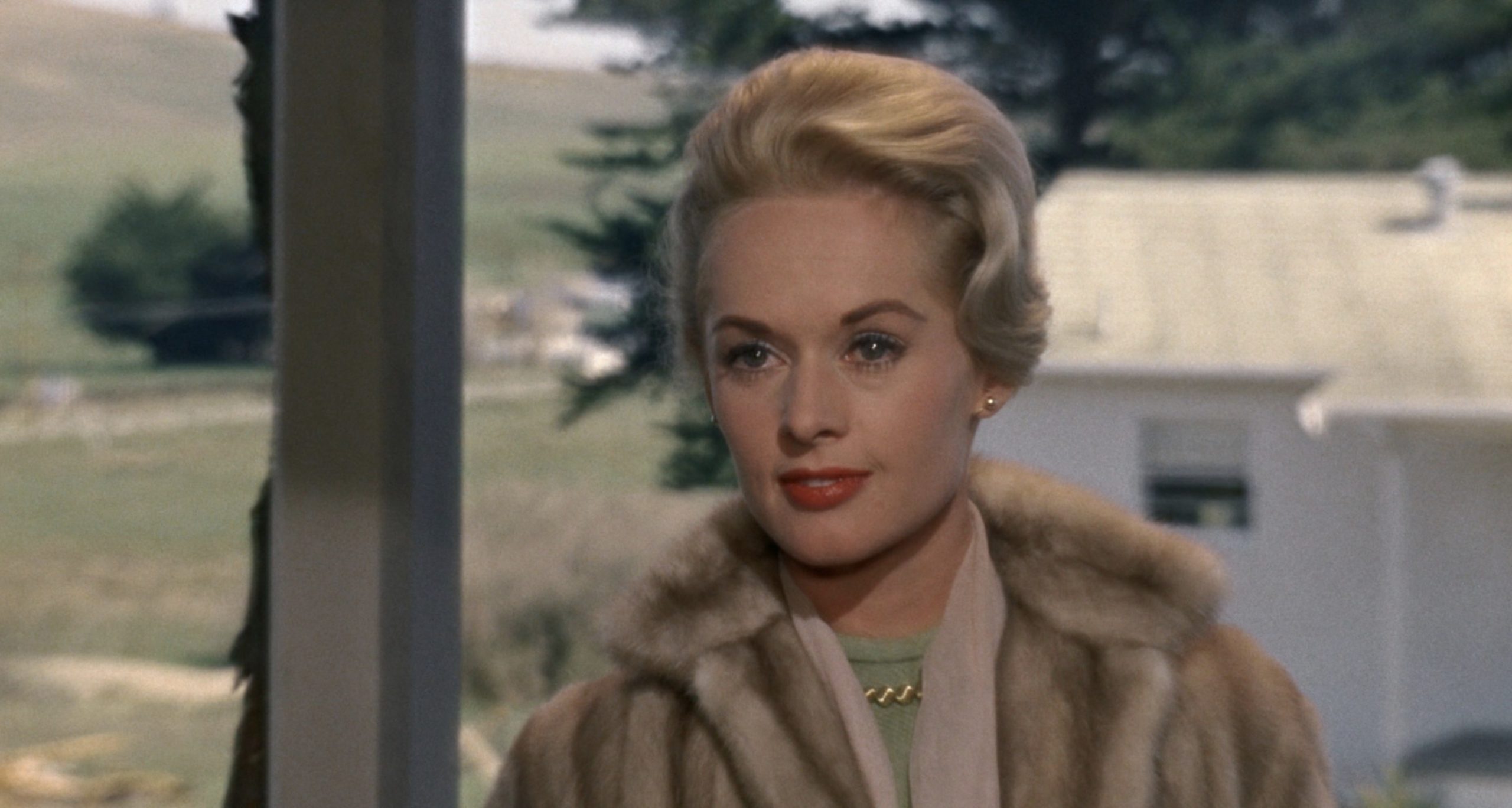
Rod Taylor is Mitch Brenner, a San Francisco lawyer who spends weekends back home in Bodega Bay with his mother and sister. Hitchcock, known for casting strong leading men such as Cary Grant and James Stewart, cast the Australian-born actor who’d first gained fame in The Time Machine (1960).
Jessica Tandy is Lydia Brenner, Mitch’s hyper-possessive mother who immediately dislikes Melanie. The London-born actress had starred in films since the 1930s and had previously appeared in three different episodes of the TV show Alfred Hitchcock Presents in the late 1950s.
Suzanne Pleshette is schoolteacher Annie Hayworth, a former lover of Mitch’s who moved to Bodega Bay after they broke up just so she could be near him. Like Jessica Tandy, she’d previously starred in Alfred Hitchcock Presents in a 1960 episode called “Hitch Hike.” Hitchcock later asked her to take a supporting role in his next film, Marnie, but she refused, insisting she was leading-lady material and was no longer content to play second fiddle.
Veronica Cartwright is Cathy Brenner, Mitch’s 11-year-old sister, although she was 14 at the time of filming. In the 1970s, she became known for her roles in Invasion of the Body Snatchers and Alien.
Ethel Griffies is Mrs. Bundy, an ornithologist who explains in the restaurant to Melanie that birds don’t have the capacity to organize mass attacks on humans.
Other supporting players include comedian Doodles Weaver as a boating assistant, Joe Mantell as a wisecracking traveling salesman, Karl Swenson as an alcoholic at the diner who keeps quoting scripture and saying “It’s the end of the world!,” and Doreen Lang as an anxious mother of two young children who winds up getting slapped by Melanie after blaming her for the bird attacks.
The Trailers
As with Psycho, there are two trailers for The Birds—one that gives a brief overview of key scenes, and another where Hitchcock gently rambles on for five or so minutes before there’s a surprise shot of a woman screaming at the end. Here’s the short trailer…
This gives a neat little summary of the key scenes, emphasizing the theme that birds have declared war on humanity. This would would be screened in theaters and at drive-ins in the months preceding the official release of The Birds on March 29, 1963. Here is the Hitchcock narration or long trailer:
This is a tongue-in-cheek review of all the brutality mankind has done to birds. Hitchcock, apparently roaming around in his man cave, shows a plumed hat and says, “How proud the birds must have been to have their feathers plucked out to brighten man’s drab life.” After declearing that “The turkey is traditionally our guest of honor on Thanksgiving,” he sits down to carve into a chicken dinner, then thinks better of it. He walks up to a caged canary, which bites his finger. “Ooh! Now why would he do that? Most peculiar!” Then Tippi Hedren runs in the room terrified and yells, “They’re coming! They’re coming!” Countless screeching black birds appear on a white background, followed by the headlines:
WHAT IS THE SHOCKING MYSTERY OF THE BIRDS?
THEY MASSED BY THE THOUSANDS
AND TENS OF THOUSANDS
WHY? WHAT WAS THEIR EVIL INTENT?
SUSPENSE AND SHOCK
BEYOND ANYTHING YOU HAVE EVER SEEN
OR IMAGINED!
“The Birds could be the most terrifying picture I have ever made.” —Alfred Hitchcock
Plot
The film starts on the streets of San Francisco in 1963. In a wink to the diet soft drink commercial that made Alfred Hitchcock first take notice of a model named Tippi Hedren, we see the blonde and beautiful Hedren get wolf-whistled at by a boy as she’s walking toward a pet shop.
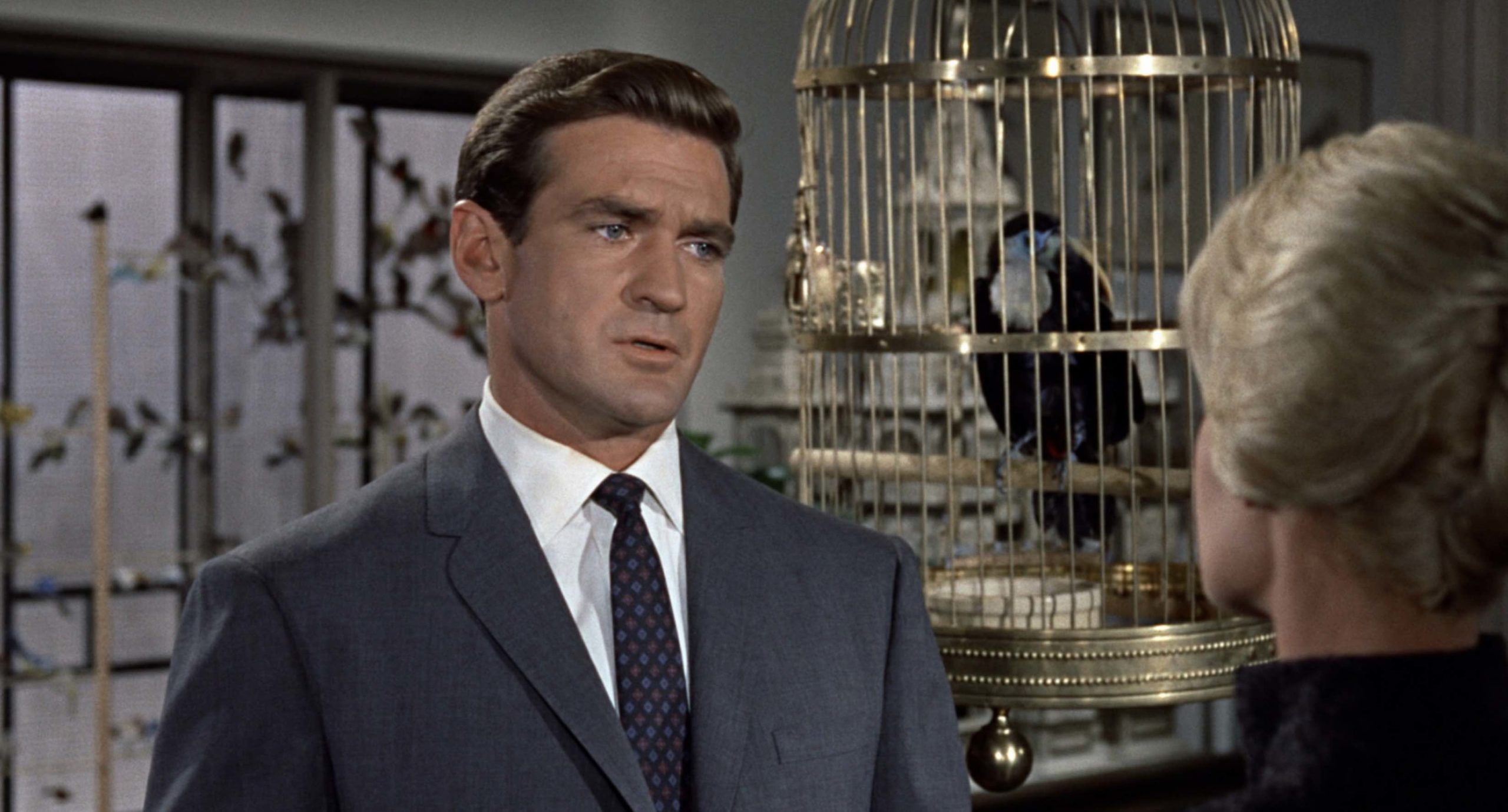
In the pet shop, she runs across a rugged lawyer named Mitch Brenner (Rod Taylor), who recognizes her as the super-rich spoiled socialite daughter of a newspaper owner. He strings her along for a while as she pretends to work at the store and then scolds her once the prank is revealed. But he left her with the notion that he was looking for a pair of lovebirds to give his sister Cathy for her 11th birthday.
With plenty of time on her hands and a newfound romantic interest in Mitch, Hedren buys the lovebirds and tries to leave them outside Mitch’s apartment door, but she’s informed that Mitch is up in Bodega Bay with his family for the weekend, and it’s probably not a good idea to leave a pair of birds unattended in the hallway for the entire weekend.
A bit of a stalker, she takes the birds and heads up in her sports car to Bodega Bay and asks around about Mitch. She is told that his family farm is across the water, so she rents a motorboat and—fully dressed as if she’s attending an opera premiere—motors across the water toward Mitch. She sneaks into his house, leaves the lovebirds, and heads back to town. By now, Mitch is aware she’s in town, so he heads in his car back to meet her as she brings the boat into dock.
Moments before she lands back in town, a seagull swoops out of nowhere and pecks her on the head. Mitch takes her into a nearby restaurant for first aid. Melanie spends the first night at the home of schoolteacher Annie Hayworth (Suzanne Pleshette), who reveals to her that she and Mitch were once romantically involved. They hear a thud at Annie’s front door and discover that a gull has killed itself by flying straight into the door.
The next day at Cathy’s birthday party, guests are attacked by gulls. Mitch’s mother, an intensely jealous woman who reveals to him that she does not like Melanie, notices that her chickens are refusing to eat, so she heads out to a local farmer’s house to see if he’s experiencing the same thing. What she notices is that his windows are smashed, the house is in shambles, and he’s dead in one room with his eyes having been pecked out of their sockets.
Fearing for Cathy’s safety, Melanie offers to pick her up at school. While she’s waiting outside on a park bench, you see crows slowly assemble on the monkey bars in the playground behind her. She warns Annie that the children need to be evacuated, but as they’re running down the street from the schoolhouse into town, they are brutally attacked by the crows.

Frantic and rattled, Melanie meets Mitch at a bayside restaurant, where a group of citizens have a discussion about whether birds are even capable of attacking humans. While they’re talking, a man who’s pumping gas maybe 100 feet from the restaurant is knocked off his feet by a gull, causing the nozzle to fall to the ground and fill the street with gasoline. Inside the restaurant, terrified onlookers see a man getting out of his car and lighting a cigar. They plead with him not to throw his match to the ground, but it’s too late—he does, and both he and his car explode, and half of downtown is ablaze.
An aerial shot shows a swarm of gulls descending for another attack on the town. Melanie runs for safety into a phone booth, only for gulls to shatter the glass by purposely flying into it. Mitch rescues her and brings her back into the restaurant, where a hysterical woman accuses Melanie of being “evil” and of causing the bird attacks.
When Mitch and Melanie visit Annie’s house to retrieve Cathy, they find that Annie has been pecked to death by birds and is lying on the stairs to the house’s front porch—and Cathy is sobbing alone inside.
That night the Brenners and Melanie huddle inside the Brenner home, where Mitch has carefully boarded up every possible entrance in anticipation of another bird attack. They eventually attack—and it’s a relentless scene, especially one shot of a back door that you see is being systematically pecked open by the birds.
Then, just as quickly as they arrived, the birds are gone. The rest of the family eventually falls asleep, but Melanie is still awake. Hearing some rustling sounds upstairs, she decides to investigate with a flashlight. When she enters the attic, she is beset by a swarm of hostile birds who peck her into unconsciousness. Mitch eventually awakes and rescues her but realizes they need to take her to a hospital. When he tries applying first aid to Melanie’s wounds, she wakes up and starts thrashing as if she’s still being attacked.
Mitch very slowly retrieves Melanie’s sports car and inches it in front of the house’s front door. Birds huddle menacingly as far as the eye can see. He squeezes Melanie, Lydia, and Cathy into the car. The final shot shows the car crawling down the driveway toward town, surrounded by what literally looks like millions of birds. And then the screen fades to black.
Analysis
Hitchcock—who may have been a bit of a sadist—seems to cheat the viewer by offering no resolution at the end and no explanation as to why the birds attacked. But he later told talk-show host Dick Cavett that they attacked because humans took nature for granted. Therefore, those who view The Birds as the pioneer in the “nature’s revenge” genre of horror movies are correct.
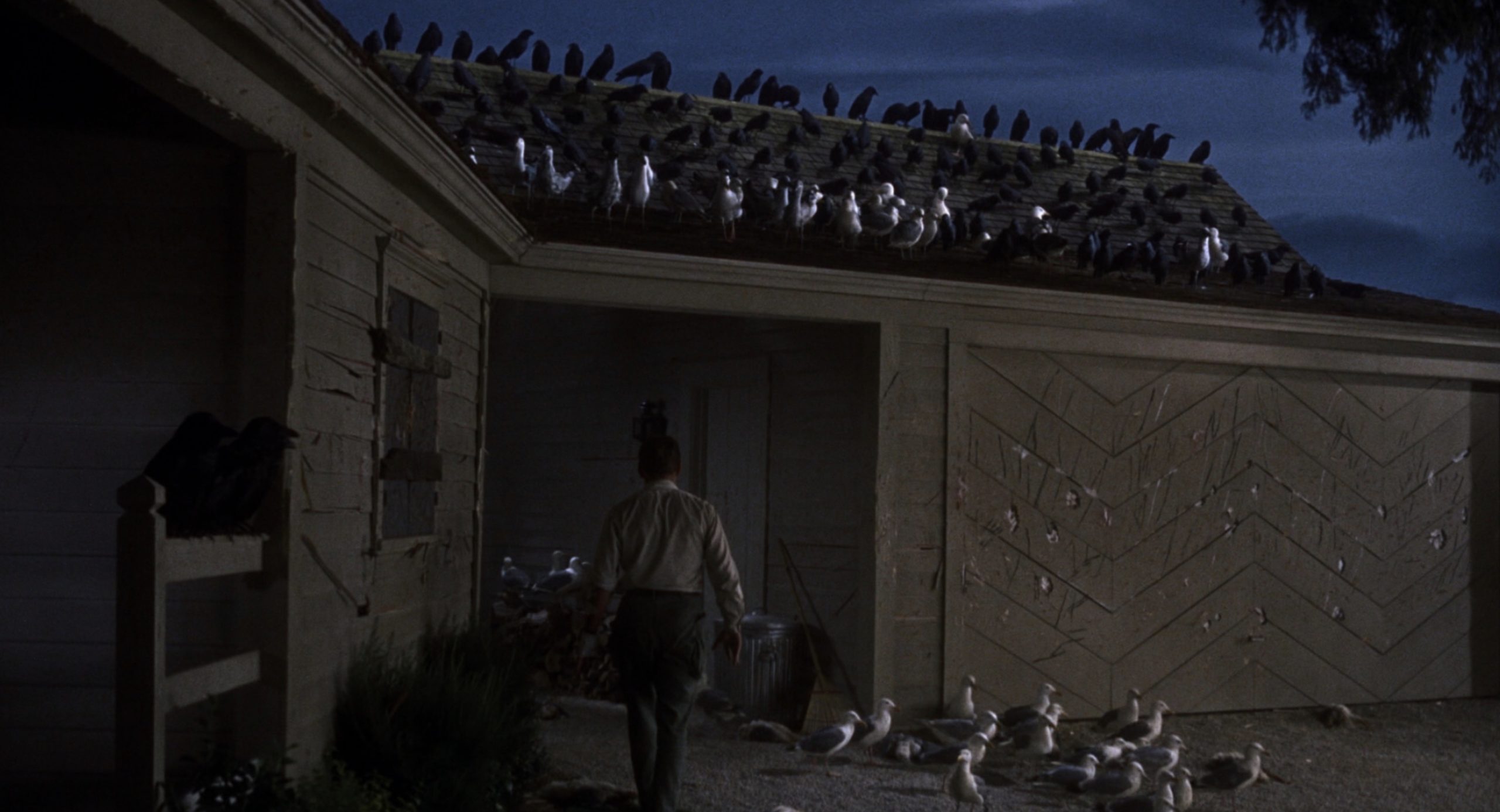
Hitchcock also more broadly stated that the film was about complacency—the central characters were all involved with vain and petty struggles until nature gave them something real and deadly with which to struggle.
Film critic Andrew Sarris echoes the complacency theme in his 1998 review:
The theme [of the film], after all, is complacency, as the director has stated on innumerable occasions. When we first meet each of the major characters, their infinite capacity of self-absorption is emphasized. Tippi Hedren’s bored socialite is addicted to elaborately time-consuming practical jokes. Rod Taylor’s self-righteous lawyer flaunts his arrogant sensuality, Suzanne Pleshette, his ex-fiancée, wallows in self-pity, and Jessica Tandy, his possessive mother, cringes from her fear of loneliness.
With such complex, unsympathetic characters to contend with, the audience begins to identify with the point of view of the birds, actually the inhuman point of view…
Feminist renegade Camille Paglia says the film is an exploration of female violence and sees the bird attacks as a metaphor for Lydia’s possessive jealousy of her son.
Critic Margaret M. Horwitz takes much the same tack:
I believe that in The Birds, as in Psycho, the heroine is punished by the hero’s mother because of the heroine’s desirability to him. This process is a result of the male character’s inability to successfully resolve an Oedipal relationship. In Psycho the mother and son are united in the character of Norman, whose psychotic behavior is revealed and explicated at the end of the film. The Birds is interesting precisely because it contains no such resolution.
In fact The Birds cannot be fully explained at a manifest level because of a process of distortion deriving from a latent level and appearing in the text as the supernatural—namely, the wild birds. For this reason a psychoanalytic model is most appropriate. My contention is that the birds’ aggressive behavior is a displacement for maternal possessiveness (exemplified by Lydia Brenner) to which Melanie poses a threat. In this view, the bird attacks function primarily as extensions of Lydia’s hysterical fear of losing her son, Mitch.
Movie Ending Explained
Why doesn’t it say “The End” at the end of film? In Hitchcock’s original planned ending, the Brenners and Melanie don’t merely crawl down their driveway while surrounded by an ocean of birds—they make it all the way down to the Golden Gate Bridge, only to discover that every inch of it is also covered by birds. The film studio shot this idea down, saying that viewers would think it signaled that the world was ending—which was precisely Hitchcock’s intention. Although they slapped a “The End” on the original version against his wishes, all of the restored copies of the film end with a simple fadeout while the family is inching away from their home.
It seems like a happy ending, but again, four people are inching away in a tiny sports car with a flimsy convertible top and are surrounded by birds as far as the eye can see. Hitchcock deliberately left the ending unclear because it’s more terrifying that way. It’s also more realistic—happy endings usually only happen in movies. In fact, “happy ending” is sort of an oxymoron.
And although Hitchcock later explained in interviews that the birds attack because man had taken nature for granted, he leaves you hanging in the movie. They seem to attack for no reason whatsoever—which makes it far more unsettling.
Soundtrack/Soundscapes
As the story goes, Bernard Herrmann—composer of the unforgettable Psycho soundtrack—recommended that there be no music at all in The Birds. In fact, the only music you hear is performed by the actors—Melanie briefly plays the piano at the Brenners’ house, and schoolchildren sing a folk song while unaware that crows are amassing outside.
Instead of soundtrack music, Hitchcock employed a machine called the Mixtur-Trautonium to electronically generate birdlike sounds. Hitchcock’s innovation here was to use silence as “music”—toward the end of the film, you’d tense up at the sound of silence because you realized that the next thing you’d hear was a screeching cacophony of birds.
Controversy: Tippi Hedren’s claims of sexual harassment
Hitchcock reportedly became infatuated with professional model Tippi Hedren ever since he saw her in a 1961 TV ad for a diet soft drink. After flying her in and having her read the parts of female leads from some of his previous classics such as Notorious, he signed Hedren—who had no acting experience—to a seven-year exclusive contract.
Although she kept quiet until Hitchcock’s death, Hedren later claimed that the famous director—possibly no director in history became as famous just for being a director as did Alfred Hitchcock—became obsessed with her and groped her in a “sexual” way. Costar Rod Taylor confirms this. She also says that after she rejected his advances, he deliberately set out to injure her during filming. In the scene where a gull pierces the glass in the phone booth where Hedren is hiding, she received cuts on her face.
In the climactic scene where Hedren’s character slinks up to the attic to investigate suspicious sounds and is nearly pecked to death by birds, Hitchcock attached several birds to her dress with nylon strings so they couldn’t escape, which frustrated them to the point where they kept attacking her. The scene reportedly took seven days to shoot—“The worst week of my life,” according to Hedren—and she wound up in the hospital due to both injuries and mental exhaustion.
Here is the scene. WARNING: It is extremely graphic in the vein of the shower scene in Psycho.
Hedren claims that out of spite, Hitchcock ruined her film career by keeping her bound to the seven-year contract she’d signed, killing all other acting opportunities up until the point where she was nearly 40 years old. Her daughter, actress Melanie Griffith, claims that when she was six, Hitchcock gave her a “prank” gift depicting her mother as a wax figure in a tiny coffin.
Frequently Asked Questions
Where was the movie ‘The Birds’ filmed? Although several scenes—such as the one where Melanie is boating across a lake when a seagull suddenly attacks her—were shot in the studio with “natural” backgrounds superimposed, primary scenery was filmed in the real-life California town of Bodega Bay, which is 67 miles north of San Francisco.
Why did the birds attack? Hitchcock told interviewer Dick Cavett that the birds attacked because humans took nature for granted. He also stated on numerous occasions that the film’s main theme was complacency—in the first hour you’re subjected to a series of vain and self-absorbed humans who are suddenly forced to drop all the silly little things they’re doing because they’ve been brought face-to-face with nature’s raw fury.
What kind of birds were used? The studio spent an estimated quarter-million dollars using mechanical birds for some of the more technically complicated scenes. Some of the ‘birds’ you see were actually hand puppets. Many were trained live birds. In 1968, Hitchcock told talk-show host Dick Cavett that 3,200 real-life birds were also used in the filming. He said that the ravens were the smartest and the seagulls were the most violent. There are rumors of birds being tranquilized and wired in place. The seagulls were reportedly captured from the San Francisco garbage dump. Sparrows were also captured from the wild and used alongside pet-shop sparrows for the scene where they invade the Brenners’ house through the chimney.
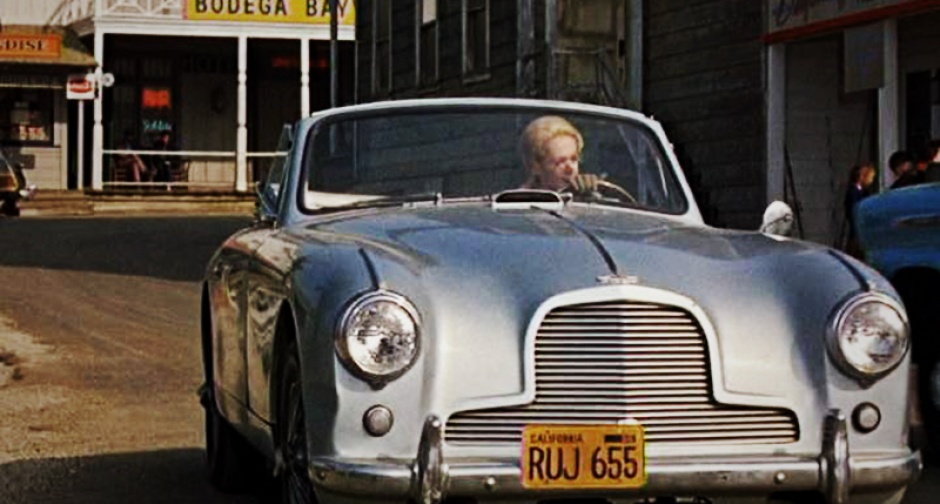
What kind of car did Melanie Daniels drive in The Birds? The super-sporty silver road-hugging convertible racer that Tippi Hedren tools up to Bodega Bay—and into which she and the entire Brenner family squeeze into and crawl away while surrounded by millions of birds at the ending—is an Aston Martin DB2/4 Drophead Coupé.
What do the lovebirds mean? The lovebirds that Melanie buys for Mitch seem to be the only nonviolent birds in the entire film. They also obviously symbolize the budding romance between Melanie and Mitch.
Sequel

Thirty-one years after The Birds—and 14 years after Alfred Hitchcock had died—there was a widely criticized TV sequel called The Birds II: Land’s End. Tippi Hedren briefly appears, but not as her original character.
Best Way to Watch/Stream
You can rent The Birds on YouTube, iTunes, Google Play, Vudu, and Amazon Prime. It is not currently streaming on Netflix or Hulu, but it is available on the streaming services fuboTV and SundanceTV. The Birds is available on DVD for at BestBuy. The Blu-ray version is more expensive. You can also stream the HD version on Amazon Prime.